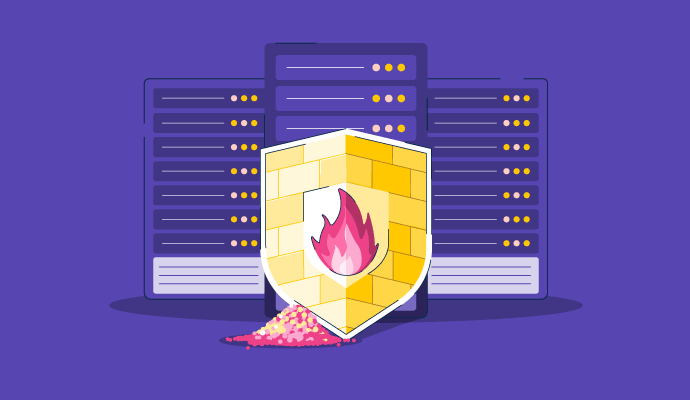
APIs are the backbone of many applications. But granting unrestricted access to them is like leaving your house's front door wide open.
You wouldn't let just anyone in, would you? Sure, some guests are welcome – the ones bringing delicious treats (those are always welcome). But others? Not so much.
Similarly, certain internal services need access to your APIs, but malicious traffic can exploit vulnerabilities and wreak havoc. This is where web application firewall (WAF) solutions step in.
A Web Application Firewall (WAF) is a security tool that protects web applications by filtering and monitoring incoming and outgoing traffic. It helps block threats like SQL injection, cross-site scripting (XSS), and other cyberattacks, ensuring the safety and reliability of web applications.
But simply deploying a WAF isn't enough. Understanding how it works empowers you to fine-tune its configuration, maximizing your application's security posture.
The architecture of a WAF typically involves several key elements and configurations that collectively enhance the security posture of web applications.
Integrating your WAF with other security solutions strengthens your defenses and streamlines management.
Here's a powerful arsenal of tools:
A web application firewall operates at Layer 7 of the open systems interconnection (OSI) model, the application layer. This is the highest layer of the network stack and deals with the actual data being transmitted, such as web pages, emails, and file transfers.
The WAF intercepts all incoming traffic directed toward web apps. It inspects all communication requests before they reach the web server.
The WAF meticulously examines each inbound request and analyzes the content based on predefined security policies and rules for the patterns and characteristics associated with various web application vulnerabilities.

WAFs compare elements within the request (e.g., HTTP headers, parameters, payload) against its security rule set to make it easy to pinpoint suspicious elements within the request.
Supported by a comprehensive suite of cybersecurity rules, WAFs stay vigilant against a spectrum of web application attacks, including:
WAFs also prevent the exploitation of missing security patches, misconfigurations, insecure building practices, and third-party or open-source plugins. However, you can integrate a cloud-based platform that protects against distributed denial of service (DDoS) attacks. If the WAF detects a DDoS attack, it can transfer the traffic to the DDoS protection platform.
WAFs can follow predefined protocols if a request violates a security rule. These actions may involve:
WAFs only work effectively if the security rule set is current. Policies should be regularly updated to cover the latest known attack vectors and vulnerabilities.
Explore the 5 best penetration testing tools and enhance your network security alongside your WAF!
While WAFs and traditional network firewalls play a critical role in network security, they target different aspects of network traffic with distinct functionalities.
For example, organizations that handle credit card data need next-generation firewalls as part of their security measures. While a basic firewall protects the network perimeter, WAFs layer on additional security for web applications that process or store cardholder data to better comply with payment card industry data security standard (PCI DSS) requirements for protecting cardholder data.
WAFs employ various methods to inspect incoming traffic and identify suspicious requests.
In this model, all incoming traffic is allowed by default. WAFs then analyze and filter requests against your rules and known harmful patterns (threat signatures). This approach offers quick implementation but has limitations.
The positive security model only gives access to the whitelist, aka the allowlist, aka traffic that conforms to predefined safe patterns.
Even though the positive approach provides superior security against zero-day attacks, it requires frequent updates to accommodate new legitimate requests. Modern WAFs can use machine learning and threat intelligence to automate whitelist updates, minimizing manual intervention.
Contemporary WAFs primarily rely on negative security models or blacklists. For comprehensive protection, WAFs can integrate positive security. This means the requests that pass negative security filters undergo anomaly detection to identify deviations from typical user behavior. If anomalies are found, the traffic source might be blocked or undergo additional scrutiny in subsequent interactions.
A hybrid approach often emerges as the most pragmatic solution. The balance between security and flexibility strengthens your organization's defense against new cyber threats.
WAFs deploy a multi-layered defense strategy against diverse threats. Various blocking mechanisms are discussed here.
Rate limiting mitigates DDoS attacks by restricting the requests a user or IP address can submit within a certain time frame.
WAFs establish a safe threshold for legitimate traffic volume. Any requests that go over this limit from a specific IP address are blocked as a way of preventing attackers from overwhelming the server with a barrage of requests. Users are left with uninterrupted access, and you maintain business continuity by safeguarding servers from overload.
WAFs secure application programming interfaces (APIs) by meticulously filtering requests. Scrutinizing API requests guarantees adherence to authorized parameters and established authentication protocols. Any deviation from these criteria triggers a blocking response to safeguard APIs from unauthorized access and exploitation.
Bot mitigation distinguishes between legitimate users and harmful, automated bots that scrape sensitive data packets or launch credential-stuffing attacks. WAFs employ a combination of techniques to identify malicious bots.
It offers a straightforward approach to blocking requests from known malicious IP addresses. WAFs maintain blacklists of IP addresses associated with prior bad behavior.
All requests that originate from these blacklisted sources are automatically blocked to prevent repeat attacks. However, this approach relies on a static list of known threats and is vulnerable to new or sophisticated attacks that haven't yet been identified.
WAFs restrict access to web applications based on geographical location. The apps can be configured to block requests from specific countries or regions deemed high risk for cyberattacks. Implement this approach with caution to avoid inadvertently blocking legitimate traffic.
WAFs analyze incoming requests and compare them against comprehensive security rules to detect and block malicious activity.
WAFs utilize two primary categories of security rules:
When a request triggers a rule match, the WAF assigns a score based on the severity of the deviation from the expected behavior. This score contributes to the request's overall risk assessment. Using a risk-based approach, WAFs provide a more enhanced response and reduce the potential for false positives by not blocking every deviation from the norm.
3 different types of WAF deployment models can cater to your web application's specific needs and architecture.
Cloud-based WAFs, delivered as a software as a service (SaaS) model, are a game-changer for businesses seeking total web application security without the burden of managing infrastructure.
Here's why cloud-based WAFs are ideal for so many organizations.
Cloud-based WAFs are a compelling option for businesses of all sizes. They provide a cost-effective way to achieve enterprise-grade web application security, regardless of your internal security expertise.
However, it's important to consider potential limitations.
On-premise WAFs give organizations a high degree of control over their security posture. You install and manage these WAF solutions directly on your own infrastructure, giving you granular customization options over security rules and configurations.
Here's what makes on-premise WAFs attractive to specific organizations.
As with all security measures, on-premise WAFs also come with some key considerations.
On-premise WAFs are a strong choice for organizations that prioritize granular control over their security environment and have the resources to manage it properly. They are well-suited for businesses in regulated industries, those with complex security needs, or those with concerns about data privacy.
Hybrid WAFs draw from the strengths of both cloud-based and on-premise deployments. Here's how they can share responsibilities to provide a comprehensive security posture.
The optimal WAF deployment model depends on your organization's security needs, technical expertise, and budget. Cloud-based WAFs are popular for their simplicity and scalability, on-premise WAFs offer greater control, and hybrid deployments balance both approaches.
While web application firewalls are powerful security tools, they have limitations to consider.
Web application firewall solutions secure web applications against cyberattacks. The top picks for 2025 are:
*These are the five leading WAF software solutions from G2's Fall 2024 Grid® Report.

Understanding how a web application firewall works is just the first step. This knowledge empowers you to choose a WAF tailored to your application and implement ongoing monitoring for optimal protection.
By being proactive, you can transform your WAF from a basic security measure into a powerful shield against cyberattacks. Don't wait for a breach - take action now!
Learn how RASP safeguards your website from within, detecting and stopping attacks in real time.
Devyani Mehta is a content marketing specialist at G2. She has worked with several SaaS startups in India, which has helped her gain diverse industry experience. At G2, she shares her insights on complex cybersecurity concepts like web application firewalls, RASP, and SSPM. Outside work, she enjoys traveling, cafe hopping, and volunteering in the education sector. Connect with her on LinkedIn.
What is a zero-day attack? A zero-day attack refers to a cybersecurity threat that occurs...
 by Rachana Hasyagar
by Rachana Hasyagar
What is web security? Web security, synonymous with “cyber security,” is a broad category of...
 by Amanda Hahn-Peters
by Amanda Hahn-Peters
As an IT security specialist, you’re on the frontline of a constant battle against cyber...
.png) by Devyani Mehta
by Devyani Mehta
What is a zero-day attack? A zero-day attack refers to a cybersecurity threat that occurs...
 by Rachana Hasyagar
by Rachana Hasyagar
What is web security? Web security, synonymous with “cyber security,” is a broad category of...
 by Amanda Hahn-Peters
by Amanda Hahn-Peters


.png?width=400&name=G2CM_FI1093_Learn_Article_Images_%5BContinuous_monitoring%5D_V1b%20(1).png)